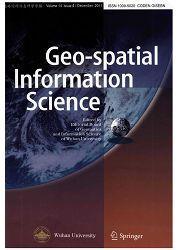A novel fuzzy inference method for urban incomplete road weight assignment
IF 5.5
1区 地球科学
Q1 REMOTE SENSING
引用次数: 0
Abstract
One of the keys in time-dependent routing is determining the weight of each road network link based on traffic information. To facilitate the estimation of the road’s weight, Global Position System (GPS) data are commonly used in obtaining real-time traffic information. However, the information obtained by taxi-GPS does not cover the entire road network. Aiming at incomplete traffic information on urban roads, this paper proposes a novel fuzzy inference method. It considers the combined effect of road grade, traffic information, and other spatial factors. Taking the third law of geography as the basic premise, that is, the more similar the geographical environment, the more similar the characteristics of the geographical target will be. This method uses a Typical Link Pattern (TLP) model to describe the geographical environment. The TLP represents typical road sections with complete information. Then, it determines the relationship between roads lacking traffic information and the TLPs according to their related factors. After obtaining the TLPs, this method ascertains the weight of road links by calculating their similarities with TLPs based on the theory of fuzzy inference. Aiming at road links at different places, the dividing – conquering strategy and globe algorithm are also introduced to calculate the weight. These two strategies are used to address the excessively fragmented or lengthy links. The experimental results with the case of Newcastle show robustness in that the average Root Mean Square Error (RMSE) is 1.430 mph, and the bias is 0.2%; the overall RMSE is 11.067 mph, and the bias is 0.6%. This article is the first to combine the third law of geography with fuzzy inference, which significantly improves the estimation accuracy of road weights with incomplete information. Empirical application and validation show that the method can accurately predict vehicle speed under incomplete information.一种新的城市不完全道路权重分配模糊推理方法
基于交通信息确定路网各链路的权值是时变路由的关键之一。为了方便估计道路的重量,通常使用全球定位系统(GPS)数据来获取实时交通信息。然而,出租车gps获取的信息并不能覆盖整个道路网络。针对城市道路交通信息不完全的问题,提出了一种新的模糊推理方法。它考虑了道路等级、交通信息和其他空间因素的综合影响。以地理第三定律为基本前提,即地理环境越相似,地理目标的特征也就越相似。该方法采用典型链接模式(TLP)模型来描述地理环境。TLP表示具有完整信息的典型路段。然后,根据缺乏交通信息的道路与tlp的相关因素确定两者之间的关系。该方法在得到tlp后,基于模糊推理理论,通过计算其与tlp的相似度来确定道路节点的权重。针对不同位置的路段,引入了分治策略和全局算法来计算权重。这两种策略用于解决过于分散或冗长的链接。以纽卡斯尔为例的实验结果显示出鲁棒性,平均均方根误差(RMSE)为1.430 mph,偏差为0.2%;总体RMSE为11.067 mph,偏差为0.6%。本文首次将地理第三定律与模糊推理相结合,显著提高了信息不完全情况下道路权重的估计精度。经验应用和验证表明,该方法能准确预测不完全信息下的车速。
本文章由计算机程序翻译,如有差异,请以英文原文为准。
求助全文
约1分钟内获得全文
求助全文
来源期刊

Geo-spatial Information Science
REMOTE SENSING-
CiteScore
10.10
自引率
28.30%
发文量
710
审稿时长
31 weeks
期刊介绍:
Geo-spatial Information Science was founded in 1998 by Wuhan University, and is now published in partnership with Taylor & Francis. The journal publishes high quality research on the application and development of surveying and mapping technology, including photogrammetry, remote sensing, geographical information systems, cartography, engineering surveying, GPS, geodesy, geomatics, geophysics, and other related fields. The journal particularly encourages papers on innovative applications and theories in the fields above, or of an interdisciplinary nature. In addition to serving as a source reference and archive of advancements in these disciplines, Geo-spatial Information Science aims to provide a platform for communication between researchers and professionals concerned with the topics above. The editorial committee of the journal consists of 21 professors and research scientists from different regions and countries, such as America, Germany, Switzerland, Austria, Hong Kong and China.
 求助内容:
求助内容: 应助结果提醒方式:
应助结果提醒方式:


